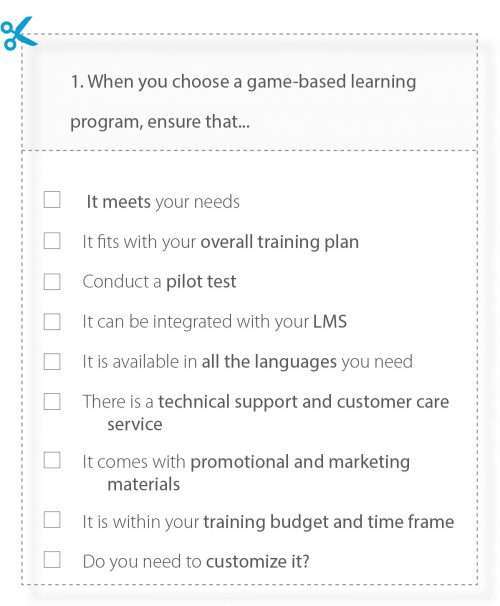Now that you have decided to implement a game-based learning program, it’s time to make an important decision: What provider to choose?What type of video game? What game will best meet your company’s needs?
To make the right choice and provide useful and effective training, we recommend you follow these tips:
1. Get involved in the training
Game-based learning, like any other teaching method (classroom training, e-learning, etc.), is merely a channel through which knowledge is transmitted or a skill practiced. Do not expect a miracle or have false expectations. As with any other training program, you will have to make an effort to identify the challenges for your workforce, motivate employees and monitor the learning experience.
You may be interested: Ebook – How to successfully implement a game-based learning program in your company
2. Find the most suitable serious game for you
Before launching a game-based learning program, it is essential that you are clear on what you want your employees to learn. There are video games to teach soft skills, such as leadership and negotiation, games specifically designed to teach practical skills (such as how to perform a surgical procedure or land a plane) and games for memorizing products and internal company processes. It’s a mistake to think that game-based learning is a one-size-fits-all solution. Therefore, identify your requirements and choose the serious game that will best meet those needs.
3. Use it as part of your overall training plan
Experience has demonstrated that the most successful game-based learning programs are the ones that are combined with other initiatives within the company (classroom training, e-learning courses, practical training, etc.). By including game-based learning as part of a broader and more comprehensive initiative, you will increase its effectiveness several-fold and reinforce the development of knowledge and skills that are important to your company.
4. Available to all employees
Your employees will probably want the flexibility to be able to play the game on their computer, tablet or mobile phone. It is also essential that you find out whether the product can be integrated with your Learning Management System (LMS). Do not forget to tell your provider what platforms you need (Would your employees prefer to use their smartphones? Is the LMS regularly used in the company?) and ensure that the game-based learning program will run smoothly on the system.
5. Multi-Language
One of the great advantages of e-learning (and, indeed, game-based learning) is that it can be implemented quickly and easily anywhere in the world. If your workforce is spread across several countries or regions, make sure your vendor can provide the product in all the languages you need.
6. Communication materials
To motivate employees to play the game, it is important that your provider can supply materials that you can use before, during and after the training. By materials we mean trailers, leaflets, emails and/or videos. If a serious game has all of these, you significantly increase the chances that the game-based learning program will be a success.
You may be interested: Merchants, serious game on negotiation and conflict resolution
7. Technical support
Because of the plethora of platforms and browsers your employees are likely to use, it is important that your vendor can provide a good quality technical support and customer care service. The better the service, the better the learning experience will be and the easier it will be for students to acquire knowledge and practice skills.
8. Time and money
Obviously, the serious game you choose must be within your budget and the time available to complete the training. How long does it take to complete each game? Does it need to be customized? If so, what will this cost and how long will it take? While some game-based learning programs can be completed in just a few hours, others take days, weeks and even months to complete, so bear this in mind when choosing a provider.
9. Do you need to customize the video games?
More and more providers offer the possibility of customizing their products. Assess whether you need to work on transversal skills or if, to the contrary, you need to customize the content to the specific features of your business. The second option may be interesting if you want to strengthen your brand equity and adapt the games to your company’s internal processes. However, bear in mind that you will need time, money and knowledge to do this properly.
Checklist






